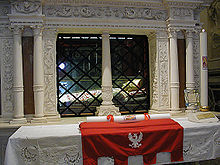Santa Maria di Collemaggio
S. Maria di Collemaggio is a large Romanesque- early Gothic church in L'Aquila , famous for its architecture, the extraordinary facade in the jewel box style made of red and white stones and the grave of the Order's founder and Pope Celestine V , who founded the church. It is picturesquely located on the outskirts of the city in a park. As the former main church of the religious order of the Coelestines , it belonged to a monastery building, of which the cloister and remains of the refectory can still be seen today. The church bears the title of a minor basilica .
history

The church dates back to 1274. At this time the hermit and founder of the order Pietro del Murrone, who later became Pope Celestine V, returned from the Council of Lyon , where he had achieved recognition of his order. On his way back he spent the night on the Collemaggio hill in front of L'Aquila and received there in a dream from Mary , who appeared to him on a golden staircase and surrounded by angels, the instruction to build a church. Pietro acquired the land in 1287 and construction began the following year, which was completed in 1289.
When Pietro was elected Pope Celestine V in 1294, he was crowned on August 29th in his new religious church of Santa Maria di Collemaggio and awarded it a privilege of indulgence : all the faithful who came to the church on August 28th and 29th Praying and receiving communion year after receiving the sacrament of penance should receive perfect indulgence . From then on, the church developed into a place of pilgrimage and quickly became famous as such when Celestine V died in 1296, canonized in 1313 and was buried in Santa Maria di Collemaggio in 1326.
During the earthquake in L'Aquila on April 6, 2009, the church was badly damaged, with the crossing and part of the apse collapsing. The buried glass reliquary with the bones of Pope Celestine V could, however, be recovered undamaged from the rubble. Shortly after the earthquake, Pope Benedict XVI. During his visit to the church on April 28, 2009, his pallium , which he had received when he took office, was deposited at the reliquary of Celestine V. The shrine was then transferred to the crypt of Sulmona Cathedral , near which St. Celestine V lived as a hermit for a long time.
organ
Until the earthquake in 2009 there was a valuable organ in the church , which was built by an unknown organ builder at the end of the 17th century. The instrument was largely destroyed in the earthquake. It had 14 stops on one manual (F, G, A – c 4 : Principale Basso 12 ′, Principale Primo 12 ′, Principale Secondo, Ottava, Quintadecima, Decimanona, Vigesimaseconda, Vigesimasesta, Vigesimanona, Trigesimaterza, Flauto in V, Flauto in VII, Tromboni 12 ′, Usignoli), and an attached pedal (F – g sharp 0 ).
Individual evidence
- ^ Basilica di S. Maria di Collemaggio on gcatholic.org
- ↑ L'Unità on April 6, 2009 ( Memento of the original from April 9, 2009 in the Internet Archive ) Info: The archive link has been inserted automatically and has not yet been checked. Please check the original and archive link according to the instructions and then remove this notice.
- ^ Spiegel.de: picture of the damaged church
- ^ Spiegel.de: Image of the recovered bones
- ↑ Information about the organ (Italian)
Web links
Coordinates: 42 ° 20 ′ 34.1 " N , 13 ° 24 ′ 16.7" E



